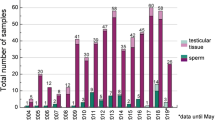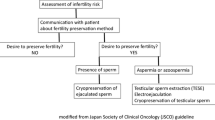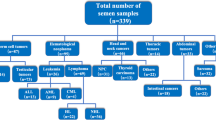Abstract
Purpose
The objective of our study was to evaluate the reproductive outcome of male cancer survivors treated with intracytoplasmic sperm injection (ICSI) using cryopreserved sperm and compare it with the same treatment in non-cancer males.
Methods
We retrospectively analyzed database derived from cancer and non-cancer patients undergoing sperm cryopreservation from August 2008 to August 2012 at a university-based center. We evaluated the reproductive outcome of those cancer and non-cancer patients that had frozen sperm and returned subsequently to the clinic for assisted reproduction.
Results
We studied 272 males with cancer and 296 infertile males. The most prevalent types of cancer in our cohort were lymphoma (25.3 %), testicular cancer (19.2 %), leukemia (7.3 %), and other malignancies including sarcoma, gastrointestinal, and central nervous system malignancies (48.2 %). The use rate of cryopreserved sperm was 10.7 % for cancer patients and 30.7 % for non-cancer patients. The mean age of males with cancer who returned to the clinic for fertility treatment was 36.7 ± 6 years, and the diagnoses were testis cancer (43.4 %), lymphoma (36.9 %), leukemia (13 %), and other malignancies (6.7 %). Live birth rate of the cancer cohort was 62.1 %, which was higher than that of the normospermic non-cancer population (p < 0.0047).
Conclusions
The use rate of cryopreserved sperm from oncofertility preservation cases is at around 10 %. The live birth rate using assisted reproductive technologies among these patients is at least comparable to that of the non-cancer population.
Implications for Cancer Survivors
To our knowledge, this was the first comparative study of male cancer survivors treated with ICSI using cryopreserved sperm, which were compared to non-cancer males undergoing the same treatment. Male fertility preservation is a highly valued service that should be strongly encouraged prior to beginning cytotoxic cancer treatment. These results can help healthcare professionals in oncology to improve the quality of counseling on fertility preservation when managing young men with newly diagnosed cancer that require gonadotoxic treatment.

Similar content being viewed by others
References
Fernbach A, Lockart B, Armus CL, Bashore LM, Levine J, Kroon L, et al. Evidence-based recommendations for fertility preservation options for inclusion in treatment protocols for pediatric and adolescent patients diagnosed with cancer. J Pediatr Oncol Nurs. 2014;31(4):211–22.
Siegel R, Ma J, Zou Z, Jemal A. Cancer statistics, 2014. CA Cancer J Clin. 2014;64(1):9–29.
Schover LR. Patient attitudes toward fertility preservation. Pediatr Blood Cancer. 2009;53(2):281–4.
Ethics Committee of American Society for Reproductive Medicine. Fertility preservation and reproduction in patients facing gonadotoxic therapies: a committee opinion. Fertil Steril. 2013;100(5):1224–31.
Lee SJ, Schover LR, Partridge AH, Patrizio P, Wallace WH, Hagerty K, et al. American Society of Clinical Oncology recommendations on fertility preservation in cancer patients. J Clin Oncol. 2006;24(18):2917–31.
Pacey AA, Eiser C. The importance of fertility preservation in cancer patients. Expert Rev Anticancer Ther. 2014;14(5):487–9.
Goossens E, Tournaye H. Male fertility preservation, where are we in 2014? Ann Endocrinol (Paris). 2014;75(2):115–7.
Kim ED. Controversy over the use of fresh versus frozen–thawed sperm for in vitro fertilization–intracytoplasmic sperm injection. Fertil Steril. 2014;101(2):336.
Anger JT, Gilbert BR, Goldstein M. Cryopreservation of sperm: indications, methods and results. J Urol. 2003;170(4 Pt 1):1079–84.
Shufaro Y, Schenker JG. Cryopreservation of human genetic material. Ann N Y Acad Sci. 2010;1205:220–4.
WHO. World Health Organization WHO laboratory manual for examination and processing of human semen. 5th edition: Cambridge University Press 2010
Bhattacharya S, Maheshwari A, Mollison J. Factors associated with failed treatment: an analysis of 121,744 women embarking on their first IVF cycles. PLoS One. 2013;8(12):e82249.
Son WY, Chung JT, Henderson S, Reinblatt S, Buckett W, Chan PT, et al. Fertilization and embryo development with spermatozoa obtained from testicular sperm extraction into oocytes generated from human chorionic gonadotropin-primed in vitro maturation cycles. Fertil Steril. 2013;100(4):989–93.
Zarutskie PW, Muller CH, Magone M, Soules MR. The clinical relevance of sex selection techniques. Fertil Steril. 1989;52(6):891–905.
Schover LR. Rates of postcancer parenthood. J Clin Oncol. 2009;27(3):321–2.
Botchan A, Karpol S, Lehavi O, Paz G, Kleiman SE, Yogev L, et al. Preservation of sperm of cancer patients: extent of use and pregnancy outcome in a tertiary infertility center. Asian J Androl. 2013;15(3):382–6.
Hourvitz A, Goldschlag DE, Davis OK, Gosden LV, Palermo GD, Rosenwaks Z. Intracytoplasmic sperm injection (ICSI) using cryopreserved sperm from men with malignant neoplasm yields high pregnancy rates. Fertil Steril. 2008;90(3):557–63.
Ping P, Zhu WB, Zhang XZ, Yao KS, Xu P, Huang YR, et al. Sperm banking for male reproductive preservation: a 6-year retrospective multi-centre study in China. Asian J Androl. 2010;12(3):356–62.
Schmidt KL, Larsen E, Bangsboll S, Meinertz H, Carlsen E, Andersen AN. Assisted reproduction in male cancer survivors: fertility treatment and outcome in 67 couples. Hum Reprod. 2004;19(12):2806–10.
van Casteren NJ, van Santbrink EJ, van Inzen W, Romijn JC, Dohle GR. Use rate and assisted reproduction technologies outcome of cryopreserved semen from 629 cancer patients. Fertil Steril. 2008;90(6):2245–50.
Dohle GR. Male infertility in cancer patients: review of the literature. Int J Urol. 2010;17(4):327–31.
Bahadur G, Ozturk O, Muneer A, Wafa R, Ashraf A, Jaman N, et al. Semen quality before and after gonadotoxic treatment. Hum Reprod. 2005;20(3):774–81.
Bonetti TC, Pasqualotto FF, Queiroz P, Iaconelli Jr A, Borges Jr E. Sperm banking for male cancer patients: social and semen profiles. Int Braz J Urol. 2009;35(2):190–7. discussion 7–8.
Hotaling JM, Lopushnyan NA, Davenport M, Christensen H, Pagel ER, Muller CH, et al. Raw and test-thaw semen parameters after cryopreservation among men with newly diagnosed cancer. Fertil Steril. 2013;99(2):464–9.
Johnson MD, Cooper AR, Jungheim ES, Lanzendorf SE, Odem RR, Ratts VS. Sperm banking for fertility preservation: a 20-year experience. Eur J Obstet Gynecol Reprod Biol. 2013;170(1):177–82.
Grigorescu V, Zhang Y, Kissin DM, Sauber-Schatz E, Sunderam M, Kirby RS, et al. Maternal characteristics and pregnancy outcomes after assisted reproductive technology by infertility diagnosis: ovulatory dysfunction versus tubal obstruction. Fertil Steril. 2014;101(4):1019–25.
Harb HM, Gallos ID, Chu J, Harb M, Coomarasamy A. The effect of endometriosis on in vitro fertilisation outcome: a systematic review and meta-analysis. BJOG. 2013;120(11):1308–20.
Templeton A, Morris JK, Parslow W. Factors that affect outcome of in-vitro fertilisation treatment. Lancet. 1996;348(9039):1402–6.
Dean JH, Chapman MG, Sullivan EA. The effect on human sex ratio at birth by assisted reproductive technology (ART) procedures—an assessment of babies born following single embryo transfers, Australia and New Zealand, 2002–2006. BJOG. 2010;117(13):1628–34.
Hesketh T, Min JM. The effects of artificial gender imbalance. Science & society series on sex and science. EMBO Rep. 2012;13(6):487–92.
Check JH, Kwirenk D, Katsoff D, Press M, Breen E, Baker A. Male:female sex ratio in births resulting from IVF according to swim-up versus Percoll preparation of inseminated sperm. Arch Androl. 1994;33(1):63–5.
Hentemann MA, Briskemyr S, Bertheussen K. Blastocyst transfer and gender: IVF versus ICSI. J Assist Reprod Genet. 2009;26(8):433–6.
Maalouf WE, Mincheva MN, Campbell BK, Hardy IC. Effects of assisted reproductive technologies on human sex ratio at birth. Fertil Steril. 2014;101(5):1321–5.
Chang HJ, Lee JR, Jee BC, Suh CS, Kim SH. Impact of blastocyst transfer on offspring sex ratio and the monozygotic twinning rate: a systematic review and meta-analysis. Fertil Steril. 2009;91(6):2381–90.
Lin PY, Huang FJ, Kung FT, Wang LJ, Chang SY, Lan KC. Comparison of the offspring sex ratio between cleavage stage embryo transfer and blastocyst transfer. Taiwan J Obstet Gynecol. 2010;49(1):35–9.
Luna M, Duke M, Copperman A, Grunfeld L, Sandler B, Barritt J. Blastocyst embryo transfer is associated with a sex-ratio imbalance in favor of male offspring. Fertil Steril. 2007;87(3):519–23.
Setti AS, Figueira RC, Braga DP, Iaconelli Jr A, Borges Jr E. Gender incidence of intracytoplasmic morphologically selected sperm injection-derived embryos: a prospective randomized study. Reprod Biomed Online. 2012;24(4):420–3.
Fedder J, Loft A, Parner ET, Rasmussen S, Pinborg A. Neonatal outcome and congenital malformations in children born after ICSI with testicular or epididymal sperm: a controlled national cohort study. Hum Reprod. 2013;28(1):230–40.
Acknowledgments
The authors would like to thank Dr. Xun Zhang for his expertise in statistical analysis for all data in this study. This study was supported by a research grant from the Canadian Institutes for Health Research (CIHR) (SUR-103396) to Dr Peter Chan.
Conflict of interest
Ainhoa García, María Belén Herrero, Hananel Holzer, Togas Tulandi, and Peter Chan declare that they have no conflict of interest.
Author information
Authors and Affiliations
Corresponding author
Additional information
Ainhoa García and María Belén Herrero contributed equally to the development of the manuscript.
Rights and permissions
About this article
Cite this article
García, A., Herrero, M.B., Holzer, H. et al. Assisted reproductive outcomes of male cancer survivors. J Cancer Surviv 9, 208–214 (2015). https://doi.org/10.1007/s11764-014-0398-7
Received:
Accepted:
Published:
Issue Date:
DOI: https://doi.org/10.1007/s11764-014-0398-7




